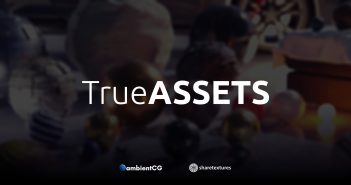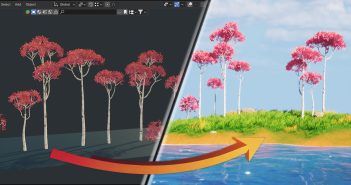INTRODUCTION
Hey, I’m Daniel, aka Harpiart, and I’m an artist from Brazil. Since I was a kid, I wanted to be a game developer. So in 2019, I enrolled on a Unity 3D game dev course, but quickly noticed I actually didn’t like to code! Discovering the world of modeling in the same course, I found out that what I really wanted to become was what I least expected: an artist. Since then, I’ve been studying from courses, animation school, and some YouTube videos to level up my skills.
INSPIRATION
I worked mainly with this concept made by Agustin Marceillac. Scrolling through Artstation, I felt it to be very special and decided to model it. I wanted to test my skills and model something very complex, which I knew would take a lot of time (It took me around 90 hours!)
From the beginning, I wasn’t really worried about modeling it fast but just study the process carefully and try to learn new things. And I did learn!
I was also very inspired by the artworks by André Kent, such as the one below. The textures, particularly, look amazing. They’re a mixture of a stylized base color channel with a bit of light painted on it, followed by PBR maps. The goal was to reach the same quality in my work.
PROCESS
Software
Mainly, I used Blender 4.0.2 (It extended until 4.1.1) for sculpting, retopologizing, rigging, UV unwrapping, and finally rendering. For baking and texturing, I used Adobe Substance Painter 2021. Besides that, I also used Affinity Photo, Krita, and PureRef.
For addons, I used Rigify to help me with the rigging, which is packed within Blender. Externally, I used UVPackMaster for the UV’s. Also, not an addon but a Geometry Node pack made by Rakenval was used for making the hair cards, which in this case were the petals on the top of its head.
Sculpting
I started with a simple blockout of the character, trying to understand primarily the proportions, using basic shapes such as cylinders. The horns started with a skin modifier, which is great for this initial setup of the sculpt. I think the second image was done on the same day.
I then spent a long time (some weeks) refining the basic shapes, adding a few more elements, such as the shoulder accessories, and later working on the small details of the character, such as these grooves it has along most of its body, as well as small adjustments to the proportions. I was always checking the main concept to make sure everything was right but at the same time, not sticking too much to the reference, and making it look good as a 3D model, not just a copy from a drawing.
I also remade the wooden chest and the wood on its forearms. This last image is most of the high poly mesh, which I used for retopology.
Retopology
Probably the longest part of the project was the retopology. At least, the time spent taught me an important lesson: to just keep things simple! Manual retopology can be actually easy if you just focus on the main loops first and then fill the rest of the faces, instead of trying to place each vertex one by one.
Some addons can help too, such as Retopoflow. It’s super useful for making the loops for arms, legs, and horns. That would save me 8 hours at least. I didn’t know about this addon when working on this character yet.
Rigging
As I mentioned earlier, I used Rigify for this character and it was my first experience with the addon. It’s tricky to use, but works well. In the picture, all the controllers of the rig are shown.
Even being tricky, Rigify does a great job with transforming a base armature into another with controllers, IK and FK limbs with switches and tweak bones. In my case, I set the character’s legs to be rear paws, so it has this characteristic animal movement.
Almost everything on this rig moves, including the skirt which was a bit hard to rig. The rig must help the animator, who has to make sure the legs, for example, don’t clip outside of the skirt. For now, it uses something similar to one of Pierrick Picaut tutorials about skirt rigging, where he teaches a very useful mechanism to keep the skirt down when the character spine rotates, like fake gravity and tweak bones.
The tweak bones float around the skirt, close to the tips of the leaves. They can be moved to adjust the mesh and avoid the clipping I mentioned.
To be honest, I didn’t like the result of this skirt rig and found it confusing. I’ll probably rework this in the future.
Texturing
Texturing is always my favorite part, and for this project, I made sure I studied many texture references to achieve better results when painting which made a big difference.
After baking the texture maps based on the high poly sculpt, I started to paint the base color channel.
With basic round brushes, I painted the grooves the character has, with the help of a curvature mask too. After having a solid base set, I did some variations on the colors, planning to make something organic and painterly. Mixing a bit of warm colors on its skin and horns worked very well to achieve textures that look alive. I repeated this process for the other parts.
I kept in mind the “materials” too. The horn, for example, has a painting on its base color that makes it look a bit shinier.
When almost done, I set up the roughness and metallic maps, just changing their values on some of the layers worked fine. I also set very subtle bump maps, just to help with the wooden aspect of some parts of the character.
Having baked information from a high poly mesh was very helpful for painting, since I could use light based masking, curvature masks, and other tools in Substance.
Leaves
Everything related to leaves in this character was a big challenge for me! Starting with the skirt the character uses, I tried some methods: one-faced leaves, and later leaves with a solidify modifier. The problem is that they felt too disconnected and thinking about animation, I couldn’t feel their movement would be cool or even make sense.
In the end, what I did was use the solidified leaves, connect them using remeshing, and then retopologize them, which took a long time but got the look I wanted. I did something similar for the wooden chest of the character.
These leaves on the head of the Dark Druid were a problem too. After some tests and research, I ended up using the hair cards geometry node set made by Rakenval as I mentioned earlier.
I believe something similar to what I did with the Druid skirt would have better results though, so I’ll probably change that in the future.
RENDER: The Dark Druid
More renders from other angles:
Clay renders:
Thank you for reading my article, and I hope you enjoyed it! Feel free to ask questions on my social media. Have a great day!
About the Artist
Daniel Messias, also known as Harpiart, is a 3D artist from Brasília, Brazil. He is currently in animation school and working as an asset modeler for Roblox games.



























